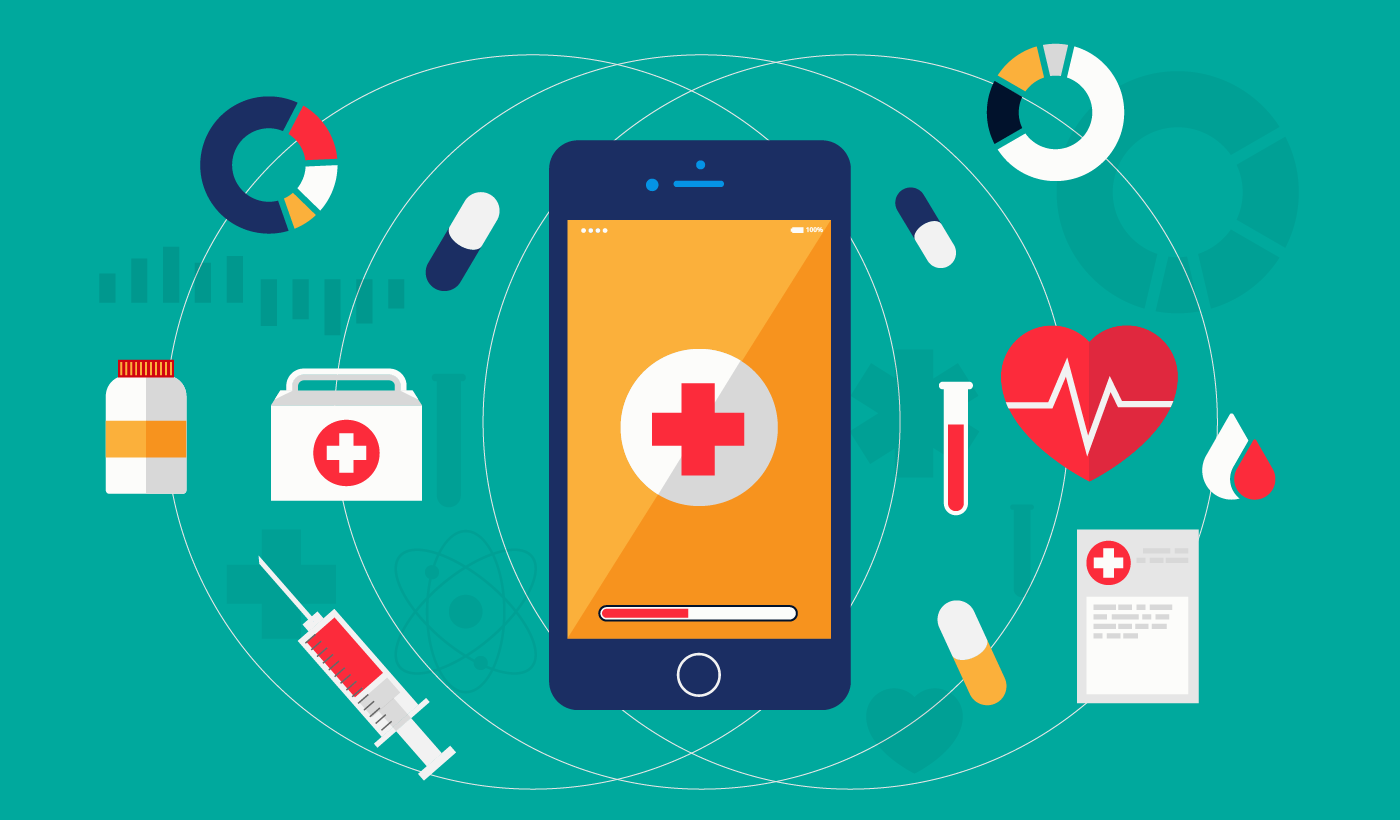Nowadays, people are more likely to resolve issues online rather than offline: they pay for services, study, and even receive treatment. Digital Health Trends 2021 researchers found that 90,000 new health apps hit the market last year. This is a third of the available medical software. Despite this digital boom, not all apps are getting accepted, with 83% of them being downloaded less than 1% of the time. Let’s figure out how to order healthcare software development that will be successful in the market.
Health Apps Market Overview
The pandemic has shown the importance of digital transformation for healthcare. With the outbreak of COVID-19, clinics and hospitals moved part of their services online and treated more patients with old staffing and inventory capabilities. Overcoming these challenges would have been more difficult without information technology and apps.
Health apps help solve various problems:
- Patients can make appointments, consult with doctors, and monitor their vital signs remotely.
- Physicians monitor patients, maintain documentation and prescribe medications;
- Healthcare institutions coordinate the work of staff members, manage inventory, create digital jobs, and train employees.
- Pharmaceutical companies develop and test medicines and look for volunteers to conduct clinical trials.
Software products improve communication between doctors and patients, allow preventing and treating diseases, and contribute to an increase in the quality and length of life. There are different types of healthcare software that have different target audiences and solve different business problems:
- Medical apps for patients such as doctor appointment software, self-diagnosis apps, mobile fitness trackers, and telemedicine platforms.
- Apps for healthcare facilities: remote patient monitoring platforms, EHRs/EMRs, clinical communication systems, prescription management software, medical data communication systems, and hospital management software.
- Software for healthcare professionals: practice management software, digital medical staff search solutions, and inventory management platforms.
The choice of an app type is one of the preparatory steps in medical projects which determines the stages of subsequent software development.

6 Steps to Successful Healthcare Software Development
In its CHAOS 2020 report, the Standish Group noted that only 31% of software projects end up being successful. Neither large serious government organizations nor small startups are immune from mistakes. The BBC lost a hundred million pounds because its project to develop a video archive system failed. The Justice Department wrote off £56m when it realized a similar program was running in the Cabinet and no duplicate was needed. To prevent such incidents from happening with custom healthcare software, you should adhere to the following strategies:
1. Outline the concept of your health app.
Healthcare software development starts with defining a product vision:
- for whom this app is created;
- what the purpose of software development is;
- what business problems the system will solve;
- what functions the program will include;
- what the competitive advantages of the software product are.
Product vision is the basic information for the development and deployment of a medical app. It is a benchmark for the healthcare software development team and the customer, through which the parties communicate and understand each other. Working without a concept is risky because you can waste investments. The most expensive and ideally implemented app will not be successful if it does not solve business and user problems.
If you are convinced that your idea will be groundbreaking, you may want to patent it for exclusive rights to profit from it. However, you may want to contact a lawyer to help you develop strategies to license your patent and protect your software idea.
2. Identify the stakeholders of your project.
For the project to proceed without obstacles and interruptions, you should identify the stakeholders who will participate in the creation of the software product. Four groups of people are involved in healthcare software development:
- A sponsor (director or manager) finances the project, cooperates with the project management team, approves the software development team, and authorizes changes in the scope of work.
- Medical experts who define healthcare software requirements. Physicians have the knowledge needed to develop industry-specific apps. Specialists know what features should be present in telemedicine software or what indicators to track diseases or what kind of records should be included in an EHR/EMR. Feedback from this group saves time and money and makes a project successful.
- A product owner is a business representative. This person solves all issues that may arise and ensures that the development team adheres to the product vision. They also correct product requirements and resolve internal team disputes.
- A development team (designers, developers, testers) who create software according to the requirements and check the quality of the system. If there are no full-time employees, the customer uses PDS – custom healthcare software development services. A business thus receives qualified specialists in a short time and saves on finding and hiring its own employees, rental costs, and utilities.
3. Prioritize tasks and calculate your budget but stay flexible.
An ideal case is when a software project is planned, requirements are carefully worked out, possible risks are taken into account, and options for their elimination are prescribed. Such preparation should save the project from failure, but it does not guarantee a hundred-per-cent success. The team probably does not know what will happen to the project. Therefore, you should outline an overall plan, within which the development team will create the product step by step, considering market trends and user needs.
To be responsive to patient needs, healthcare project customers need to work closely with the healthcare software development team. They should meet with the technology partner regularly to review progress or reprioritize tasks based on budget and deadlines. The customer always makes some changes to the project. The team needs to organize the work in such a way as to respond flexibly to any deviations from the plan and implement innovations promptly.
4. Use visualization to translate requirements for medical software.
It is not difficult for an experienced IT specialist to develop custom healthcare software. A more time-consuming process is to delve into the requirements for a software product and render them correctly. This is especially true for complex app modules and design elements that are not easy to describe in words. To learn the requirements quicker and speed up software development, you should use wireframes and prototypes.
Wireframes (static images of app screens) and prototypes (interactive models of a program) visually show the team what a product looks like. They help businesses and developers quickly come to a consensus on how to lead a software project.
In most cases, healthcare software development companies practice both frameworks and prototypes. A framework is used as a tool to reach an agreement among the stakeholders. A prototype is created to concretize how an app works. Interactively, it shows what the team is trying to achieve and what the final product will look like. Visualization simplifies work and eliminates situations where developers misinterpret and implement requirements. The team does not need to spend time and money reworking mistakes.
5. Test the idea of a medical app in the market with the help of an MVP.
According to CB Insights, the second most popular reason for software project failure is the lack of market demand. Long-term large-scale projects with millions of investments can fail if they are irrelevant to users. Therefore, businesses develop MVPs (minimum viable products) with subsequent scaling.
Such a strategy implies that developers create a basic version of a product within 1-3 months. Likewise, this is an app with the minimum critical functionality that users can work with. The MVP is released to the market to test the relevance of the idea and make sure the project is worth developing. Indeed, it is necessary to find a balance between how the business sees the app and what users really want.
If the target audience accepts the product well, the team starts scaling up the initial version taking into account the needs of users. The team collects customer feedback and, based on it, builds work in the next iterations. Specialists add only the necessary and relevant features, which will make users buy the product.
Indeed, this lean approach to development ensures projects against situations where firms spend a lot of money and time on irrelevant products.
6. Carefully plan user acceptance testing.
The success of a custom healthcare solution, like any other software product, also depends on whether the system works correctly and complies with safety and industry regulations. The customer can verify this at the stage of user acceptance testing – UAT.
UAT participants (users or medical experts) check if there are any problems with the platform. Acceptance testing is done before a product is released in a live environment. UAT needs to be planned during the requirements analysis and design phase. Certainly, this is important for medical apps that will have many users or that process large amounts of data.
Even if a system passes the necessary tests, this does not mean that the program will not fail in production. UAT can identify these failures given real-world scenarios as happened with the new terminal at Heathrow Airport (UK). The organizers of UAT did not take some critical scenarios into account. As a result, the seemingly carefully tested program broke down. When employees “pulled” luggage out of the program manually, the software turned off. As a result, about 42 thousand suitcases did not fly with their owners, and the airport had to cancel 500 flights. So due to insufficient UAT planning, the airport lost millions of pounds.
Errors in healthcare software can mean not only financial losses but also a threat to the health and life of patients. Therefore, UAT needs careful planning and efficient execution.

Conclusion
The success of a healthcare software development project depends on a complex of factors and activities: from planning to establishing communication between participants. But the technological partner plays a decisive role in this matter. When a customer has no experience in managing projects, a development team helps to bring their idea to life, proposes a development strategy, and creates a relevant product at a minimal cost.
Therefore, the best investment in a project is to find an experienced custom healthcare software development company that implements the above strategies and brings a successful product to the market.









